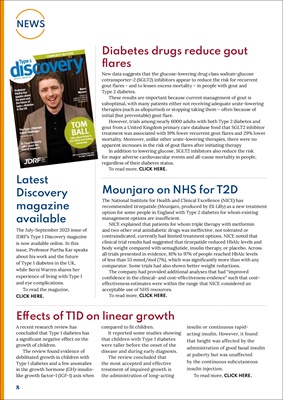
8
NEWS
Diabetes drugs reduce gout
flares
New data suggests that the glucose-lowering drug class sodium-glucose
cotransporter-2 (SGLT2) inhibitors appear to reduce the risk for recurrent
gout flares - and to lessen excess mortality - in people with gout and
Type 2 diabetes.
These results are important because current management of gout is
suboptimal, with many patients either not receiving adequate urate-lowering
therapies (such as allopurinol) or stopping taking them - often because of
initial (but preventable) gout flare.
However, trials among nearly 6000 adults with both Type 2 diabetes and
gout from a United Kingdom primary care database fond that SGLT2 inhibitor
treatment was associated with 19% fewer recurrent gout flares and 29% lower
mortality. Moreover, unlike other urate-lowering therapies, there were no
apparent increases in the risk of gout flares after initiating therapy
In addition to lowering glucose, SGLT2 inhibitors also reduce the risk
for major adverse cardiovascular events and all-cause mortality in people,
regardless of their diabetes status.
To read more, CLICK HERE.
Latest
Discovery
magazine
available
The July-September 2023
issue of JDRF's Type 1 Discovery
magazine is now available online.
In this issue, Professor Partha Kar
speaks about his work and the
future of Type 1 diabetes in the
UK, while Berni Warren shares her
experience of living with Type 1
and eye complications.
To read the magazine,
CLICK HERE.
Mounjaro on NHS for T2D
The National Institute for Health and Clinical Excellence (NICE) has
recommended tirzepatide (Mounjaro, produced by Eli Lilly) as a new treatment
option for some people in England with Type 2 diabetes for whom existing
management options are insufficient.
NICE explained that patients for whom triple therapy with metformin
and two other oral antidiabetic drugs was ineffective, not tolerated or
contraindicated, currently had limited treatment options. NICE noted that
clinical trial results had suggested that tirzepatide reduced HbA1c levels and
body weight compared with semaglutide, insulin therapy, or placebo. Across
all trials presented in evidence, 81% to 97% of people reached HbA1c levels
of less than 53 mmol/mol (7%), which was significantly more than with any
comparator. Some trials had also shown better weight reductions.
The company had provided additional analyses that had "improved
confidence in the clinical- and cost-effectiveness evidence" such that costeffectiveness
estimates were within the range that NICE considered an
acceptable use of NHS resources.
To read more, CLICK HERE.
Effects of T1D on linear growth
A recent research review has
concluded that Type 1 diabetes has
a significant negative effect on the
growth of children.
The review found evidence of
debilitated growth in children with
Type 1 diabetes and a few anomalies
in the growth hormone (GH)-insulinlike
growth factor-1 (IGF-1) axis when
compared to fit children.
It reported some studies showing
that children with Type 1 diabetes
were taller before the onset of the
disease and during early diagnosis.
The review concluded that
the most accepted and effective
treatment of impaired growth is
the administration of long-acting
insulin or continuous rapidacting
insulin. However, it found
that height was affected by the
administration of good basal insulin
at puberty but was unaffected
by the continuous subcutaneous
insulin injection.
To read more, CLICK HERE.